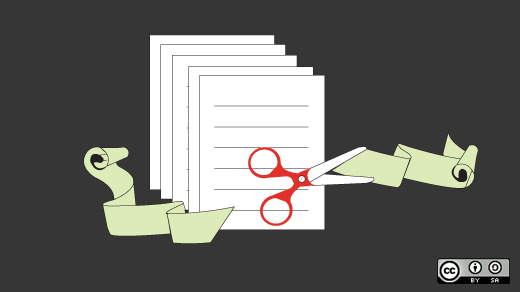If you want to run or update a task when certain files are updated, the make utility can come in handy. The make utility requires a file, Makefile (or makefile), which defines set of tasks to be executed. You may have used make to compile a program from source code. Most open source projects use make to compile a final executable binary, which can then be installed using make install.
In this article, we'll explore make and Makefile using basic and advanced examples. Before you start, ensure that make is installed in your system.
Basic examples
Let's start by printing the classic "Hello World" on the terminal. Create a empty directory myproject containing a file Makefile with this content:
say_hello:
echo "Hello World"Now run the file by typing make inside the directory myproject. The output will be:
$ make
echo "Hello World"
Hello WorldIn the example above, say_hello behaves like a function name, as in any programming language. This is called the target. The prerequisites or dependencies follow the target. For the sake of simplicity, we have not defined any prerequisites in this example. The command echo "Hello World" is called the recipe. The recipe uses prerequisites to make a target. The target, prerequisites, and recipes together make a rule.
To summarize, below is the syntax of a typical rule:
target: prerequisites
<TAB> recipeAs an example, a target might be a binary file that depends on prerequisites (source files). On the other hand, a prerequisite can also be a target that depends on other dependencies:
final_target: sub_target final_target.c
Recipe_to_create_final_target
sub_target: sub_target.c
Recipe_to_create_sub_targetIt is not necessary for the target to be a file; it could be just a name for the recipe, as in our example. We call these "phony targets."
Going back to the example above, when make was executed, the entire command echo "Hello World" was displayed, followed by actual command output. We often don't want that. To suppress echoing the actual command, we need to start echo with @:
say_hello:
@echo "Hello World"Now try to run make again. The output should display only this:
$ make
Hello WorldLet's add a few more phony targets: generate and clean to the Makefile:
say_hello:
@echo "Hello World"
generate:
@echo "Creating empty text files..."
touch file-{1..10}.txt
clean:
@echo "Cleaning up..."
rm *.txtIf we try to run make after the changes, only the target say_hello will be executed. That's because only the first target in the makefile is the default target. Often called the default goal, this is the reason you will see all as the first target in most projects. It is the responsibility of all to call other targets. We can override this behavior using a special phony target called .DEFAULT_GOAL.
Let's include that at the beginning of our makefile:
.DEFAULT_GOAL := generateThis will run the target generate as the default:
$ make
Creating empty text files...
touch file-{1..10}.txtAs the name suggests, the phony target .DEFAULT_GOAL can run only one target at a time. This is why most makefiles include all as a target that can call as many targets as needed.
Let's include the phony target all and remove .DEFAULT_GOAL:
all: say_hello generate
say_hello:
@echo "Hello World"
generate:
@echo "Creating empty text files..."
touch file-{1..10}.txt
clean:
@echo "Cleaning up..."
rm *.txtBefore running make, let's include another special phony target, .PHONY, where we define all the targets that are not files. make will run its recipe regardless of whether a file with that name exists or what its last modification time is. Here is the complete makefile:
.PHONY: all say_hello generate clean
all: say_hello generate
say_hello:
@echo "Hello World"
generate:
@echo "Creating empty text files..."
touch file-{1..10}.txt
clean:
@echo "Cleaning up..."
rm *.txtThe make should call say_hello and generate:
$ make
Hello World
Creating empty text files...
touch file-{1..10}.txtIt is a good practice not to call clean in all or put it as the first target. clean should be called manually when cleaning is needed as a first argument to make:
$ make clean
Cleaning up...
rm *.txtNow that you have an idea of how a basic makefile works and how to write a simple makefile, let's look at some more advanced examples.
Advanced examples
Variables
In the above example, most target and prerequisite values are hard-coded, but in real projects, these are replaced with variables and patterns.
The simplest way to define a variable in a makefile is to use the = operator. For example, to assign the command gcc to a variable CC:
CC = gcc
This is also called a recursive expanded variable, and it is used in a rule as shown below:
hello: hello.c
${CC} hello.c -o hello
As you may have guessed, the recipe expands as below when it is passed to the terminal:
gcc hello.c -o hello
Both ${CC} and $(CC) are valid references to call gcc. But if one tries to reassign a variable to itself, it will cause an infinite loop. Let's verify this:
CC = gcc
CC = ${CC}
all:
@echo ${CC}Running make will result in:
$ make
Makefile:8: *** Recursive variable 'CC' references itself (eventually). Stop.To avoid this scenario, we can use the := operator (this is also called the simply expanded variable). We should have no problem running the makefile below:
CC := gcc
CC := ${CC}
all:
@echo ${CC}Patterns and functions
The following makefile can compile all C programs by using variables, patterns, and functions. Let's explore it line by line:
# Usage:
# make # compile all binary
# make clean # remove ALL binaries and objects
.PHONY = all clean
CC = gcc # compiler to use
LINKERFLAG = -lm
SRCS := $(wildcard *.c)
BINS := $(SRCS:%.c=%)
all: ${BINS}
%: %.o
@echo "Checking.."
${CC} ${LINKERFLAG} $< -o $@
%.o: %.c
@echo "Creating object.."
${CC} -c $<
clean:
@echo "Cleaning up..."
rm -rvf *.o ${BINS}-
Lines starting with
#are comments. -
Line
.PHONY = all cleandefines phony targetsallandclean. -
Variable
LINKERFLAGdefines flags to be used withgccin a recipe. -
SRCS := $(wildcard *.c):$(wildcard pattern)is one of the functions for filenames. In this case, all files with the.cextension will be stored in a variableSRCS. -
BINS := $(SRCS:%.c=%): This is called as substitution reference. In this case, ifSRCShas values'foo.c bar.c',BINSwill have'foo bar'. -
Line
all: ${BINS}: The phony targetallcalls values in${BINS}as individual targets. -
Rule:
%: %.o @echo "Checking.." ${CC} ${LINKERFLAG} $< -o $@Let's look at an example to understand this rule. Suppose
foois one of the values in${BINS}. Then%will matchfoo(%can match any target name). Below is the rule in its expanded form:foo: foo.o @echo "Checking.." gcc -lm foo.o -o fooAs shown,
%is replaced byfoo.$<is replaced byfoo.o.$<is patterned to match prerequisites and$@matches the target. This rule will be called for every value in${BINS} -
Rule:
%.o: %.c @echo "Creating object.." ${CC} -c $<Every prerequisite in the previous rule is considered a target for this rule. Below is the rule in its expanded form:
foo.o: foo.c @echo "Creating object.." gcc -c foo.c -
Finally, we remove all binaries and object files in target
clean.
Below is the rewrite of the above makefile, assuming it is placed in the directory having a single file foo.c:
# Usage:
# make # compile all binary
# make clean # remove ALL binaries and objects
.PHONY = all clean
CC = gcc # compiler to use
LINKERFLAG = -lm
SRCS := foo.c
BINS := foo
all: foo
foo: foo.o
@echo "Checking.."
gcc -lm foo.o -o foo
foo.o: foo.c
@echo "Creating object.."
gcc -c foo.c
clean:
@echo "Cleaning up..."
rm -rvf foo.o fooFor more on makefiles, refer to the GNU Make manual, which offers a complete reference and examples.
You can also read our Introduction to GNU Autotools to learn how to automate the generation of a makefile for your coding project.







8 Comments